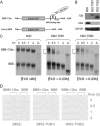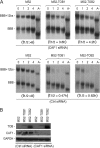Evidence providing new insights into TOB-promoted deadenylation and supporting a link between TOB's deadenylation-enhancing and antiproliferative activities
- PMID: 22252318
- PMCID: PMC3295015
- DOI: 10.1128/MCB.06370-11
Evidence providing new insights into TOB-promoted deadenylation and supporting a link between TOB's deadenylation-enhancing and antiproliferative activities
Erratum in
-
Correction for Ezzeddine et al., "Evidence Providing New Insights into TOB-Promoted Deadenylation and Supporting a Link between TOB's Deadenylation-Enhancing and Antiproliferative Activities".Mol Cell Biol. 2017 Jun 29;37(14):e00208-17. doi: 10.1128/MCB.00208-17. Print 2017 Jul 15. Mol Cell Biol. 2017. PMID: 28663272 Free PMC article. No abstract available.
Abstract
The mammalian TOB1 and TOB2 proteins have emerged as key players in repressing cell proliferation. Accumulating evidence indicates that TOBs regulate mRNA deadenylation. A recruitment model was proposed in which TOBs promote deadenylation by recruiting CAF1-CCR4 deadenylase complex to the 3' end of mRNAs by simultaneously binding CAF1 and PABP. However, the exact molecular mechanism underlying TOB-promoted deadenylation remains unclear. It is also unclear whether TOBs' antiproliferative and deadenylation-promoting activities are connected. Here, we combine biochemical analyses with a functional assay directly monitoring deadenylation and mRNA decay to characterize the effects of tethering TOBs or their mutant derivatives to mRNAs. The results provide direct evidence supporting the recruitment model and reveal a link between TOBs' antiproliferative and deadenylation-promoting activities. We also find that TOBs' actions in deadenylation are independent of the phosphorylation state of three serines known to regulate antiproliferative actions, suggesting that TOBs arrest cell growth through at least two different mechanisms. TOB1 and TOB2 were interchangeable in the properties tested here, indicating considerable functional redundancy between the two proteins. We propose that their multiple modes of modulating mRNA turnover and arresting cell growth permit the TOB proteins to coordinate their diverse roles in controlling cell growth and differentiation.
Figures








Similar articles
-
Tob2 phosphorylation regulates global mRNA turnover to reshape transcriptome and impact cell proliferation.RNA. 2020 Sep;26(9):1143-1159. doi: 10.1261/rna.073528.119. Epub 2020 May 13. RNA. 2020. PMID: 32404348 Free PMC article.
-
Human TOB, an antiproliferative transcription factor, is a poly(A)-binding protein-dependent positive regulator of cytoplasmic mRNA deadenylation.Mol Cell Biol. 2007 Nov;27(22):7791-801. doi: 10.1128/MCB.01254-07. Epub 2007 Sep 4. Mol Cell Biol. 2007. PMID: 17785442 Free PMC article.
-
TOB Proteins Repress Translation via the CCR4-NOT Deadenylase Complex Independent of Deadenylation.Genes Cells. 2025 Sep;30(5):e70042. doi: 10.1111/gtc.70042. Genes Cells. 2025. PMID: 40755205
-
BTG/TOB factors impact deadenylases.Trends Biochem Sci. 2009 Dec;34(12):640-7. doi: 10.1016/j.tibs.2009.07.008. Epub 2009 Oct 12. Trends Biochem Sci. 2009. PMID: 19828319 Free PMC article. Review.
-
The mammalian anti-proliferative BTG/Tob protein family.J Cell Physiol. 2010 Jan;222(1):66-72. doi: 10.1002/jcp.21919. J Cell Physiol. 2010. PMID: 19746446 Review.
Cited by
-
Tob2 phosphorylation regulates global mRNA turnover to reshape transcriptome and impact cell proliferation.RNA. 2020 Sep;26(9):1143-1159. doi: 10.1261/rna.073528.119. Epub 2020 May 13. RNA. 2020. PMID: 32404348 Free PMC article.
-
The Dynamic Poly(A) Tail Acts as a Signal Hub in mRNA Metabolism.Cells. 2023 Feb 10;12(4):572. doi: 10.3390/cells12040572. Cells. 2023. PMID: 36831239 Free PMC article.
-
Trypanosome MKT1 and the RNA-binding protein ZC3H11: interactions and potential roles in post-transcriptional regulatory networks.Nucleic Acids Res. 2014 Apr;42(7):4652-68. doi: 10.1093/nar/gkt1416. Epub 2014 Jan 26. Nucleic Acids Res. 2014. PMID: 24470144 Free PMC article.
-
Deadenylation of mRNA by the CCR4-NOT complex in Drosophila: molecular and developmental aspects.Front Genet. 2014 May 26;5:143. doi: 10.3389/fgene.2014.00143. eCollection 2014. Front Genet. 2014. PMID: 24904643 Free PMC article. Review.
-
The enzyme activities of Caf1 and Ccr4 are both required for deadenylation by the human Ccr4-Not nuclease module.Biochem J. 2015 Jul 1;469(1):169-76. doi: 10.1042/BJ20150304. Epub 2015 May 6. Biochem J. 2015. PMID: 25944446 Free PMC article.
References
-
- Ajima R, et al. 2008. Osteoporotic bone formation in mice lacking tob2; involvement of Tob2 in RANK ligand expression and osteoclasts differentiation. FEBS Lett. 582:1313–1318 - PubMed
-
- Anderson P, Kedersha N. 2009. RNA granules: post-transcriptional and epigenetic modulators of gene expression. Nat. Rev. Mol. Cell Biol. 10:430–436 - PubMed
Publication types
MeSH terms
Substances
Grants and funding
LinkOut - more resources
Full Text Sources
Molecular Biology Databases
